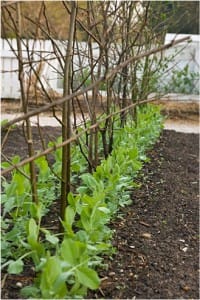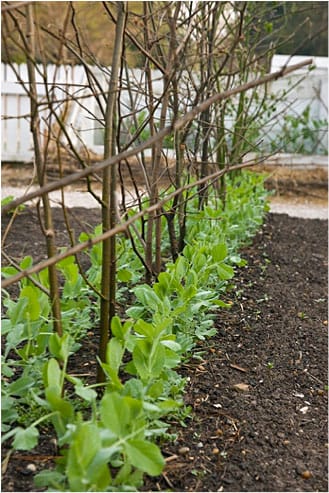Even though we are all in frozen shock with frigid winter temperatures, we are happy to report that there is garden work to do. Peas are a cool-season crop and it is almost time to plant them. Garden peas, snap peas, and snow peas all go in to the ground about the same time. Garden peas are also called English peas and require shelling as only the pea seeds are eaten. Snap peas are relatively new to the vegetable garden and the entire pea pod with seeds is eaten. Snow peas do not develop large pea seeds and the pods are often used in stir-fry dishes.

Peas require full sun and most of them require some type of trellis. The trellis is helpful to support the pea vines and to keep the pods off the ground to help prevent rot. Some pea varieties are short, only 2-3 feet tall, while others can have vines as long as six feet. Read your seed package well to know what to expect. For a community garden plot, the easiest way to manage this crop is to put the trellis at one plot end and use the other space for additional cool-season vegetables. (See UGA’s Vegetable Planting Chart for some ideas.) Some gardeners use tomato cages they already have on hand. In colonial times, tree branches were put in the ground as small twig trellises. Some people prefer to just have a pea patch.
Start with well drained soil having a pH of 6.0-6.8. Forward thinking gardeners get their pea beds ready in the Fall so that all that is needed is the planting. The seeds should be planted 1 inch deep and 1-2 inches apart. Peas work with bacteria in the soil to “fix” nitrogen. This process take a while and it could be advantageous to use nitrogen-fixing soil inoculant just before planting. You may want to split this purchase with other gardeners as the inoculants usually have an annual expiration date. The inoculants are available through many seed companies; check your seed catalogs.
Literature says to plant peas as soon as the soil can be worked. For the Southern gardener this is misleading as our soil can often be worked all year long. The trick is to plant the seeds when the soil is warm enough for germination and the plant will grow and produce the vegetable before the weather gets too warm. If seeds sit in very cold, wet soil for long they may rot. Pea vines are more resistant to freezing than the pods. This is helpful as the vines will develop first. Timing is everything!
Soil temperatures need to be at least 45 degrees F. (Check out www.georgiaweather.net.) The warmer the soil temperatures the faster the peas germinate. You can use dark plastic mulch around the seeds to warm the soil a bit. Pay attention to the days to maturity number on your seed package as this can help guide you in a planting date. For Northern Georgia start checking the soil temperatures the last week of January. Have them planted before March 1st.
Peas are best eaten as soon as possible after they are picked so harvest often. All types are delicious to snack on as you work in the garden! Some recommended varieties of garden peas are Wando (which is somewhat heat tolerant) and Little Marvel, and Improved Maestro. Wando and Little Marvel are favorites of many Master Gardeners. Some gardeners choose not to trellis these types and just to have a pea patch. If you are growing snap peas consider Sugar Snap or Sugar Daddy. Snow pea gardeners enjoy growing the Norli variety. Your UGA Extension Agent and Master Gardeners can give you information on other varieties of peas to try growing.
We close with a gardening wives’ tale – ” If a girl finds nine peas in a pod, the next bachelor she meets will become her husband.”
Happy Gardening!
